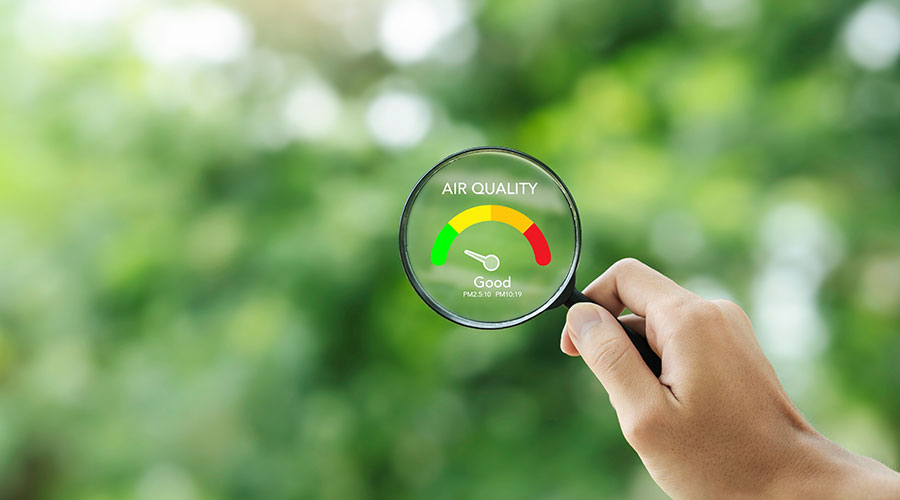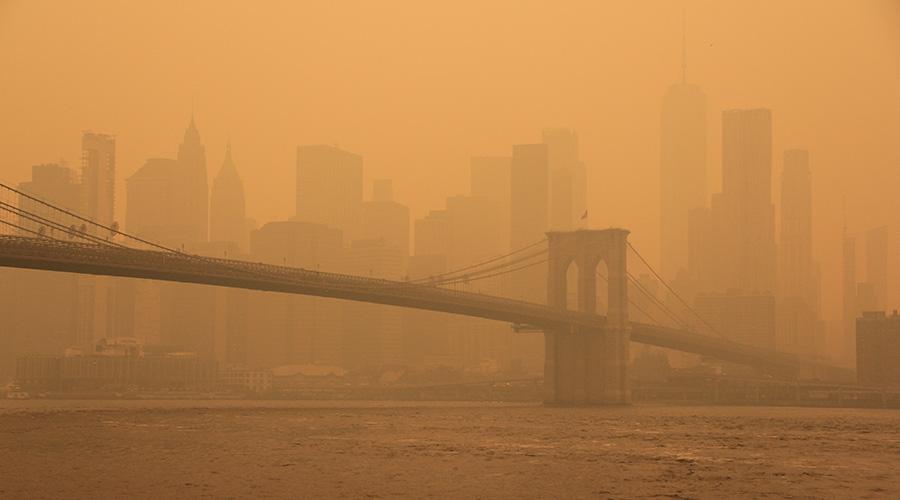Mold: What Science Says Now
Recent studies can help facility executives cut through the hype and understand the real risks of mold in buildings
By W. Elliott Horner And B.J. Spanos
The risks of indoor mold growth once again are grabbing headlines in the wake of a devastating hurricane season on the U.S. Gulf Coast. Some of the news stories report accurate information while others feature wildly unsubstantiated claims fueled by dramatic pictures of the thousands of homes and buildings damaged or destroyed by hurricanes Katrina and Rita. It is important for facility executives to be able to separate the fact from fiction about “killer” or “toxic” molds; to understand what is known about mold and its possible health effects; and to understand how to deal effectively with indoor mold growth and protect buildings and those living, working or going to school in them.
Can some molds kill? This question cannot be answered simply. Some molds and mold byproducts can be very dangerous to some people, but exposure does not automatically mean people will get sick and die. Aspergillus sp., for example, can cause a rare, serious lung condition called aspergilliosis, which can be deadly. Those most at risk are people with severely compromised immune systems, such as those undergoing chemotherapy, people with HIV/AIDS or those who have had organ or bone marrow transplants. Developing aspergilliosis is most likely to occur in health care facilities, such as hospitals, retirement homes and assisted living facilities — any place that houses people who are older or have compromised immune systems.
A variety of molds can produce mycotoxins at various times during their lifecycles. Occupants can experience health problems if they are exposed to high levels of these compounds, but this is rare in most indoor environments. Health effects include eye, nose and throat irritations; headache; dizziness; dermatitis; diarrhea; and impaired or altered immune function. Although a lot is known about the effects of ingesting certain mycotoxins, such as moldy grain in an agricultural setting, researchers have just started studying how inhaling these substances may affect health.
Inhaling large concentrations of dust with mold spores may cause lung irritation and in some instances a more serious condition called hypersensitivity pneumonitis. This condition is generally an occupational hazard in agriculture, but it has been reported in individuals in residences and among mold remediators working without appropriate protection.
Dust not only carries mold spores, but it also contains many other mold-laden particles. Two recent studies that examined dust samples showed that for every one intact spore in the air, more than 300 particles of dead parts of the mold colony or digested bits of the substrate on which the mold grew also may be in the air. (To locate these studies — labeled Górney et al. 2002 and Green et al. 2005 — and others mentioned in this article, see box below.) These particles can carry the substances that can cause immune system and allergic reactions. And because these particles are much smaller than mold spores, they can be inhaled more deeply into the lung. Dust from moldy materials is generally in the range of 2.5 microns or less, which is known to be a respiratory irritant.
Damp Buildings and Asthma
By far, the most common health impacts from mold are those associated with allergies and asthma. Researchers estimate that about 10 percent of the U.S. population is sensitive to mold allergens, with only about half, or 5 percent, expected to develop allergic symptoms from exposure to molds (American College of Occupational and Environmental Medicine 2002). Symptoms can range from mild to transitory responses — such as watery eyes, runny nose, throat irritation, coughing and sneezing — to chronic illnesses such as sinusitis and asthma.
One of the most intriguing avenues of research with respect to indoor mold growth focuses on damp buildings. Two landmark studies released earlier this year (Jaakkola et al. 2005 and Cox-Gasner et al. 2005) provide the first solid evidence that damp buildings and exposure to resultant indoor mold growth are risk factors for developing asthma and not just in making asthma symptoms worse. The results from these studies indicate that the risk for developing asthma appears higher for, but is not limited to, people who are sensitive to mold allergens or who have parents with asthma. Children are at greater risk than adults because they breathe in more air with respect to their body mass and as a result have a greater exposure to indoor environmental contaminants.
If buildings are damp — that is, they have moisture or water intrusion problems — they can support indoor mold growth. As a result, the people living, working or going to school in these buildings have a higher potential risk for developing asthma. This in turn puts facility executives and their organizations at a higher risk for liability and bad publicity.
These studies carry significant weight because many earlier studies did not follow children or adults from a time prior to their developing asthma until sometime after, nor did they independently assess the indoor environments in which the study participants lived and worked before and after they developed asthma. Another factor in these studies’ favor is that the researchers relied on medical diagnosis of the respiratory symptoms not just on interviews or surveys with adults who reported on their or their children’s symptoms.
The Jaakkola and Cox-Gasner studies also update the often-quoted 2004 Institute of Medicine report, Damp Indoor Spaces and Health (IOM 2004). This report offered a comprehensive review of the scientific literature on asthma, mold and other factors related to damp conditions in homes and buildings. The Committee on Damp Indoor Spaces and Health concluded that there is sufficient evidence that mold and damp conditions can cause asthma symptoms in people with asthma who are sensitive to mold; mold and damp conditions can also cause coughing, wheezing and upper respiratory tract symptoms in otherwise healthy people. The committee at that time did not find sufficient evidence to establish a clear, causal relationship for the development of asthma; however, the two new studies were not then available.
In addition, the Jaakkola and Cox-Gasner studies support the premise that cleaning up and preventing indoor mold growth by eliminating moisture and water intrusion is a critical factor for reducing the number of people who develop asthma and the frequency and severity of attacks among those who do have asthma.
Preventing mold growth
It is essential that facility executives not ignore mold problems or moisture and water damage, which are strong indicators that a building is prime for indoor mold growth. These problems will not go away by themselves. Left unchecked, indoor mold growth can cause serious damage to building materials and furnishings and may cause people to get sick, which can be a serious liability issue. In addition, it is far less disruptive and expensive to clean up mold as soon as a problem is found than later when the infestation may be more extensive. Bear in mind that any cleanup efforts will be for naught if the underlying moisture problem is not identified and eliminated.
When cleaning up mold, facility executives should be aware that it can look dead, but the spores can still spread and colonize other building materials. Without proper containment and removal, the risk of spreading mold spores throughout the building is very high. Without adequate protection, workers cleaning up the mold-infested area are at higher risk of inhaling enough mold spores to possibly cause health problems.
Facility executives should find a knowledgeable drying company before one is needed, as there may not be time to do a good search in a crisis. Develop a moisture management plan and establish a water-incident (burst pipe, flood, roof damage or window leakage, to name a few examples) response plan. When selecting a qualified drying company, look for those that have expertise in operating large-scale dehumidifiers, documenting activities for insurance claims and employing appropriate drying techniques to protect building integrity. Also, be sure to hire a firm with extensive experience and credentials to manage the remediation process.
Because of the complex nature of the issues and players surrounding water intrusion and mold problems in commercial and educational buildings, litigation can be an issue now or in the future. By contacting legal counsel early, facility executives can avoid potential pitfalls. Legal counsel also can provide advice on general legal issues and offer invaluable assistance with collecting information for insurance claims and negotiating with the insurance company to ensure a full and fair settlement.
New Program to Certify Facility IAQ Practices
In early 2006, facility executives will have an opportunity to attest that their buildings are designed, constructed and operated in a manner that prevents indoor mold growth. The Greenguard Environmental Institute, a non-profit organization that develops and promotes standards for indoor air quality, announced its intent to develop a national standard on the prevention of mold during the design, construction and occupancy of buildings. The Greenguard effort is unique because its standard covers practices throughout a building’s lifecycle, and because it will certify that the buildings comply with these practices. Greenguard is presently pilot testing this standard and expects to finalize it early next year.
Complying with this standard will demonstrates responsible design, construction and management, which may reduce liability and make buildings more attractive to tenants.
|
For More Information
Here is where to find the scientific studies mentioned in this article:
American College of Occupational and Environmental Medicine. “Adverse human health effects associated with molds in the indoor environment.” ACOEM Evidence-based Statement. October 27, 2002. American College of Occupational and Environmental Medicine. Arlington Heights, Illinois. 2002.
Cox-Ganser, J.M., White, S.K., Jones, R., et al. “Respiratory morbidity in office workers in a water-damaged building.” Environmental Health Perspectives. 113(4): 485 - 490. April 2005.
Górney, R.L., Reponen, T., Willeke, K., et al. “Fungal fragments as indoor air biocontaminants.” Applied and Environmental Microbiology. 68(7): 3522 - 3531. 2002.
Green, B.J., Sercombe, J.K., and Tovey, E.R. “Fungal fragments and undocumented conidia function as new aeroallergen sources.” Journal of Allergy and Clinical Immunology. 115(5): 1043 - 1048. May 2005.
Institute of Medicine of the National Academies of Science. Damp Indoor Spaces and Health. The National Academies Press. Washington, D.C. 2004.
Jaakkola, J.J.K., Hwang, B.F., Jaakkola, N. “Home dampness and molds, parental atopy, and asthma in childhood: a six-year population-based cohort study.” Environmental Health Perspectives. 113(3): 357 - 361. March 2005.
|
W. Elliott Horner, Ph.D., is principal consultant and microbial laboratory director for Air Quality Sciences (AQS), Inc., Marietta, Ga.
B.J. Spanos is managing editor, Aerias AQS IAQ Resource Center.
Related Topics:











